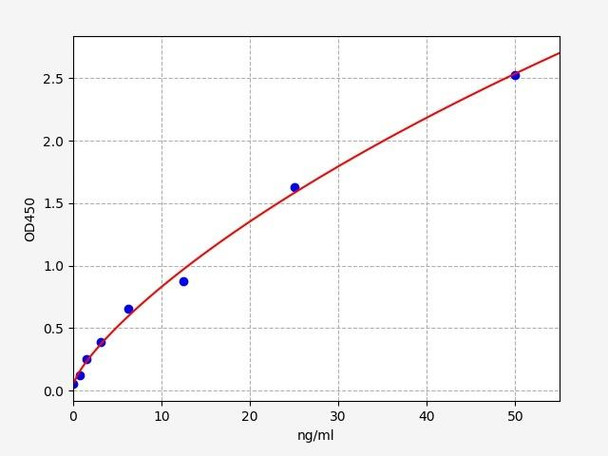Description
Human LPL (Lipoprotein lipase) ELISA
LPL (Lipoprotein lipase) functions as a homodimer, and has the dual functions of triglyceride hydrolase and ligand/bridging factor for receptor-mediated lipoprotein uptake. LPL (Lipoprotein lipase) is expressed in heart, muscle, and adipose tissue. Severe mutations that cause LPL (Lipoprotein lipase) deficiency result in type I hyperlipoproteinemia, while less extreme mutations in LPL are linked to many disorders of lipoprotein metabolism such as familial hyperlipidemia.
Key Features
| Save Time | Pre-coated 96 well plate | |
| Quick Start | Kit includes all necessary reagents | |
| Publication Ready | Reproducible and reliable results |
Overview
| Product Name: | Human LPL (Lipoprotein lipase) ELISA Kit |
| Product Code: | HUFI07671 |
| Size: | 96 Assays |
| Alias: | LPL ELISA Kit, Lipoprotein Lipase ELISA Kit, LIPD ELISA Kit |
| Detection Method: | Sandwich ELISA, Double Antibody |
| Application: | This immunoassay kit allows for the in vitro quantitative determination of Human LPL (Lipoprotein lipase) concentrations in serum plasma and other biological fluids. |
| Sensitivity: | < 0.469ng/ml |
| Range: | 0.781-50ng/ml |
| Storage: | 4°C for 6 months |
| Note: | For Research Use Only |
Additional Information
| Recovery | Matrices listed below were spiked with certain level of Human LPL (Lipoprotein lipase) and the recovery rates were calculated by comparing the measured value to the expected amount of Human LPL (Lipoprotein lipase) in samples.
| ||||||||||||||||||||
| Linearity | The linearity of the kit was assayed by testing samples spiked with appropriate concentration of Human LPL (Lipoprotein lipase) and their serial dilutions. The results were demonstrated by the percentage of calculated concentration to the expected.
| ||||||||||||||||||||
| CV(%) | Intra-Assay: CV<8% |
Kit Components
| Component | Quantity | Storage |
| ELISA Microplate (Dismountable) | 8x12 strips | 4°C for 6 months |
| Lyophilized Standard | 2 | 4°C/ -20°C |
| Sample/Standard Dlution Buffer | 20ml | 4°C |
| Biotin-labeled Antibody (Concentrated) | 120ul | 4°C (Protection from light) |
| Antibody Dilution Buffer | 10ml | 4°C |
| HRP-Streptavidin Conjugate (SABC) | 120ul | 4°C (Protect from light) |
| SABC Dilution Buffer | 10ml | 4°C |
| TMB Substrate | 10ml | 4°C (Protection from light) |
| Stop Solution | 10ml | 4°C |
| Wash Buffer (25X) | 30ml | 4°C |
| Plate Sealer | 5 | - |
Other materials required:
- Microplate reader with 450 nm wavelength filter
- Multichannel Pipette, Pipette, microcentrifuge tubes and disposable pipette tips
- Incubator
- Deionized or distilled water
- Absorbent paper
- Buffer resevoir
Protein Information
Protocol
*Note: Protocols are specific to each batch/lot. For the exact instructions please follow the protocol included in your kit.
Before adding to wells, equilibrate the SABC working solution and TMB substrate for at least 30 min at 37°C. When diluting samples and reagents, they must be mixed completely and evenly. It is recommended to plot a standard curve for each test.
| Step | Procedure |
| 1. | Set standard, test sample and control (zero) wells on the pre-coated plate respectively, and then, record their positions. It is recommended to measure each standard and sample in duplicate. Wash plate 2 times before adding standard, sample and control (zero) wells! |
| 2. | Aliquot 0.1ml standard solutions into the standard wells. |
| 3. | Add 0.1 ml of Sample / Standard dilution buffer into the control (zero) well. |
| 4. | Add 0.1 ml of properly diluted sample ( Human serum, plasma, tissue homogenates and other biological fluids.) into test sample wells. |
| 5. | Seal the plate with a cover and incubate at 37 °C for 90 min. |
| 6. | Remove the cover and discard the plate content, clap the plate on the absorbent filter papers or other absorbent material. Do NOT let the wells completely dry at any time. Wash plate X2. |
| 7. | Add 0.1 ml of Biotin- detection antibody working solution into the above wells (standard, test sample & zero wells). Add the solution at the bottom of each well without touching the side wall. |
| 8. | Seal the plate with a cover and incubate at 37°C for 60 min. |
| 9. | Remove the cover, and wash plate 3 times with Wash buffer. Let wash buffer rest in wells for 1 min between each wash. |
| 10. | Add 0.1 ml of SABC working solution into each well, cover the plate and incubate at 37°C for 30 min. |
| 11. | Remove the cover and wash plate 5 times with Wash buffer, and each time let the wash buffer stay in the wells for 1-2 min. |
| 12. | Add 90 µl of TMB substrate into each well, cover the plate and incubate at 37°C in dark within 10-20 min. (Note: This incubation time is for reference use only, the optimal time should be determined by end user.) And the shades of blue can be seen in the first 3-4 wells (with most concentrated standard solutions), the other wells show no obvious color. |
| 13. | Add 50 µl of Stop solution into each well and mix thoroughly. The color changes into yellow immediately. |
| 14. | Read the O.D. absorbance at 450 nm in a microplate reader immediately after adding the stop solution. |
Sample Type
When carrying out an ELISA assay it is important to prepare your samples in order to achieve the best possible results. Below we have a list of procedures for the preparation of samples for different sample types.
| Sample Type | Protocol |
| Serum | If using serum separator tubes, allow samples to clot for 30 minutes at room temperature. Centrifuge for 10 minutes at 1,000x g. Collect the serum fraction and assay promptly or aliquot and store the samples at -80°C. Avoid multiple freeze-thaw cycles. If serum separator tubes are not being used, allow samples to clot overnight at 2-8°C. Centrifuge for 10 minutes at 1,000x g. Remove serum and assay promptly or aliquot and store the samples at -80°C. Avoid multiple freeze-thaw cycles. |
| Plasma | Collect plasma using EDTA or heparin as an anticoagulant. Centrifuge samples at 4°C for 15 mins at 1000 × g within 30 mins of collection. Collect the plasma fraction and assay promptly or aliquot and store the samples at -80°C. Avoid multiple freeze-thaw cycles. Note: Over haemolysed samples are not suitable for use with this kit. |
| Urine & Cerebrospinal Fluid | Collect the urine (mid-stream) in a sterile container, centrifuge for 20 mins at 2000-3000 rpm. Remove supernatant and assay immediately. If any precipitation is detected, repeat the centrifugation step. A similar protocol can be used for cerebrospinal fluid. |
| Cell culture supernatant | Collect the cell culture media by pipette, followed by centrifugation at 4°C for 20 mins at 1500 rpm. Collect the clear supernatant and assay immediately. |
| Cell lysates | Solubilize cells in lysis buffer and allow to sit on ice for 30 minutes. Centrifuge tubes at 14,000 x g for 5 minutes to remove insoluble material. Aliquot the supernatant into a new tube and discard the remaining whole cell extract. Quantify total protein concentration using a total protein assay. Assay immediately or aliquot and store at ≤ -20 °C. |
| Tissue homogenates | The preparation of tissue homogenates will vary depending upon tissue type. Rinse tissue with 1X PBS to remove excess blood & homogenize in 20ml of 1X PBS (including protease inhibitors) and store overnight at ≤ -20°C. Two freeze-thaw cycles are required to break the cell membranes. To further disrupt the cell membranes you can sonicate the samples. Centrifuge homogenates for 5 mins at 5000xg. Remove the supernatant and assay immediately or aliquot and store at -20°C or -80°C. |
| Tissue lysates | Rinse tissue with PBS, cut into 1-2 mm pieces, and homogenize with a tissue homogenizer in PBS. Add an equal volume of RIPA buffer containing protease inhibitors and lyse tissues at room temperature for 30 minutes with gentle agitation. Centrifuge to remove debris. Quantify total protein concentration using a total protein assay. Assay immediately or aliquot and store at ≤ -20 °C |
| Breast Milk | Collect milk samples and centrifuge at 10,000 x g for 60 min at 4°C. Aliquot the supernatant and assay. For long term use, store samples at -80°C. Minimize freeze/thaw cycles. |
LPL Background
LPL Background
Lipoprotein lipase (LPL) is a crucial enzyme that plays a central role in lipid metabolism and energy balance within the body. Found primarily on the surface of cells in tissues such as adipose tissue, skeletal muscle, and the heart, LPL is responsible for hydrolyzing triglycerides present in circulating lipoproteins, such as chylomicrons and very-low-density lipoproteins (VLDLs). Through this enzymatic action, LPL liberates fatty acids from these lipoproteins, allowing cells to take up and utilize these fatty acids as a source of energy or for storage as triglycerides within cells.
LPL Structure and Function
Lipoprotein lipase (LPL) is a glycoprotein composed of multiple subunits that together form its functional enzyme complex. LPL is anchored to the cell surface through its interaction with glycosylphosphatidylinositol (GPI) anchors. Its primary function is to facilitate the hydrolysis of triglycerides present in circulating lipoproteins, converting them into free fatty acids and glycerol. These liberated fatty acids are then taken up by surrounding cells for energy production or storage. LPL is particularly active in tissues with high energy demands, such as skeletal muscle and adipose tissue. It is regulated by various factors, including insulin, hormones, and dietary fat intake. Dysregulation of LPL activity can lead to disturbances in lipid metabolism, contributing to conditions like hypertriglyceridemia and impaired lipid clearance. Overall, the function of LPL is essential for maintaining lipid homeostasis and ensuring a steady supply of energy-rich molecules to tissues throughout the body.
LPL FAQs
What is the Human LPL ELISA Kit used for?
The Human Lipoprotein Lipase (LPL) ELISA kit is a diagnostic tool utilized to quantify the concentration of lipoprotein lipase in human serum or plasma samples. LPL is a key enzyme involved in lipid metabolism, playing a vital role in triglyceride hydrolysis and lipid clearance. Measuring LPL levels using this ELISA kit aids in assessing lipid metabolism disorders and their association with conditions such as hyperlipidemia, obesity, and cardiovascular diseases.
What are the advantages of using the Human LPL ELISA Kit?
The Human LPL ELISA Kit offers several advantages, including high sensitivity, accuracy, and reproducibility. It provides a user-friendly and reliable method to quantify LPL levels in biological specimens, allowing for precise measurements and robust data analysis.
What sample types are compatible with Human LPL ELISA Kit?
The Human LPL ELISA Kit is compatible with various sample types, including serum, plasma, cell lysates, and tissue homogenates. It provides flexibility in sample selection, allowing researchers to analyze LPL levels in different biological matrices.
What are the storage requirements with Human LPL ELISA Kit?
The Human LPL ELISA Kit components should be stored according to the instructions provided in the kit manual. Generally, it is recommended to store the kit components at the recommended temperature to ensure their stability and optimal performance.
What should I do if my assay results are not optimal?
If you encounter any issues or have suboptimal assay results, we recommend contacting our dedicated support team for assistance. They will be available to provide troubleshooting guidance, answer your questions, and ensure you achieve the best possible results with the Human LPL ELISA Kit.










